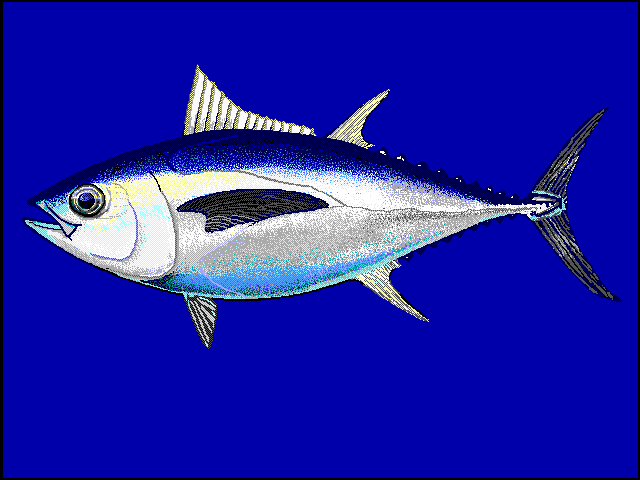- Bigeye tuna
Taxobox
name = Bigeye tuna
status = VU
status_system = iucn2.3

regnum =Animal ia
phylum = Chordata
classis =Actinopterygii
ordo =Perciformes
familia =Scombridae
genus = "Thunnus "
species = "T. obesus"
range_
range_map_caption=
binomial = "Thunnus obesus"
binomial_authority = (Lowe, 1839)The bigeye tuna, "Thunnus obesus", is an important food
fish and highly sought after recreational game fish. It is a member of the true tunas of the genus Thunnus, belonging to the wider mackerel familyScombridae .Bigeye tuna are found in the open waters of all tropical and temperate
ocean s, but not theMediterranean Sea . Its length is between 60 and 250 cm (23 and 93inch es). Maximum weight probably exceeds 400 lb with the all-tackle angling record standing at 392 lbs.A longer-lived fish than the closely related yellowfin tuna, the bigeye tuna is thought to have a lifespan of up to 10 to 12 years, with individuals achieving sexual maturity at the age of four. Spawning has been recorded as taking place in June and July in the northwestern tropical Atlantic and in January and February in the Gulf of Guinea in the eastern Atlantic, which is, so far, the only known nursery area for Atlantic bigeye tuna.
Bigeye tuna are large deep-bodied streamlined fish with large heads and eyes. The
pectoral fin s are very long, reaching back as far as the seconddorsal fin . There are 13 or 14 dorsal spines.Body colour is dark metallic blue on the back with a grey-white belly and an iridescent blue band running along each flank. The dorsal and
anal fin s are yellow.Bigeye tuna feed on a wide variety of fishes;
cephalopod s, mostly various squid species; andcrustacean s during the day and at night. Feed items include both epipelagic and mesopelagic species, with deep diving behaviour during the day thought to be related to the seeking of prey.Satellite tagging has shown that bigeye tuna often spend prolonged periods cruising deep below the surface during the daytime, sometimes making dives of deep as 500 metres. These movements are thought to be in response to the vertical migrations of prey organisms in the deep scattering layer. Physiological adaptations to foraging in these cold (bigeye tuna have been tracked entering water as cold as 5 degrees Celsius) and oxygen-poor subsurface waters include blood that is highly efficient in extracting oxygen from the water even in oxygen-poor conditions, and vision that is highly adapted for effective function in low light conditions. The heart of bigeye tuna also has an unusual ability to function effectively at the low ambient temperatures encountered while foraging in cold subsurface water. Nonetheless, bigeye tuna must make return trips to warmer surface waters to warm themselves up.
Overfishing
Bigeye tuna are amongst the tuna species most threatened by overfishing. Juvenile bigeye tuna associate closely with floating objects such as logs, buoys and other flotsam, which makes them extremely susceptible to purse seine fishing in conjunction with man-made FADs ( Fish Aggregation Devices). Bigeye mature at a later age than other commercially important tuna species such as skipjack and yellowfin tuna, and the removal of large numbers of juvenile bigeye before they reach breeding age is a major concern to fisheries managers, scientists and sport fishermen.
References
* Listed as Vulnerable (VU A1bd v2.3)
*
*
* Tony Ayling & Geoffrey Cox, "Collins Guide to the Sea Fishes of New Zealand", (William Collins Publishers Ltd, Auckland, New Zealand1982 ) ISBN 0-00-216987-8
* Clover, Charles. 2004. "The End of the Line: How overfishing is changing the world and what we eat". Ebury Press, London. ISBN 0-09-189780-7
*Richard W. Brill1, Keith A. Bigelow, Michael K. Musyl, Kerstin A. Fritsches, Eric J. Warrant, 'BIGEYE TUNA (THUNNUS OBESUS) BEHAVIOR AND PHYSIOLOGY AND THEIR RELEVANCE TO STOCK ASSESSMENTS AND FISHERY BIOLOGY'. ICCAT, 2005. http://www.soest.hawaii.edu/pfrp/reprints/iccat_bigeye.pdf
*ScienceDaily (Dec. 3, 2007), 'Turning A Blind Eye To Bigeye Tuna'. http://www.sciencedaily.com/releases/2007/11/071126144222.htm
*National Marine Fisheries Service, 'Atlantic Bigeye Tuna'. http://www.nmfs.noaa.gov/habitat/habitatprotection/profile/hms/atlantic_bigeye_tunahome.htm
Wikimedia Foundation. 2010.
